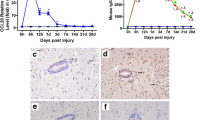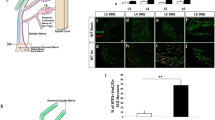Abstract
The ability to regrow their axons after an injury is a hallmark of neurons in peripheral nervous system which distinguish them from central nervous system neurons. This ability is influenced by their intrinsic capacity to regrow and by the extracellular environment which needs to be supportive of regrowth. CXCL1 [Chemokine (C-X-C motif) Ligand 1] and CXCL2 [Chemokine (C-X-C motif) Ligand 2] are two low-molecular-weight chemokines which can influence neuronal proliferation, differentiation and neurogenesis, but which are also upregulated by injury or inflammation. In this study we investigated the effects of long-term incubation (24, 48 and 72 h) with different concentrations of CXCL1 (0.4, 4 or 40 nM) or CXCL2 (0.36, 3.6 or 36 nM) on the axon outgrowth of adult rat dorsal root ganglia neurons in culture. The results showed that both chemokines significantly inhibited the axon outgrowth, with large and medium NF200 (NeuroFilament 200) (+) dorsal root ganglia neurons affected quicker, compared to small IB4 (Isolectin B4) (+) dorsal root ganglia neurons which were affected after longer exposure. Blocking CXCR2 (C-X-C motif chemokine receptor 2) which mediates the effects of CXCL1 and CXCL2 prevented these effects, suggesting that CXCR2 may represent a new therapeutic target for promoting the axon outgrowth after a peripheral nerve injury.












Similar content being viewed by others
References
Scheib J, Hoke A (2013) Advances in peripheral nerve regeneration. Nat Rev Neurol 9:668–676
Curcio M, Bradke F (2018) Axon regeneration in the central nervous system: facing the challenges from the inside. Annu Rev Cell Devl Biol 34:495–521
Nguyen QT, Sanes JR, Lichtman JW (2002) Pre-existing pathways promote precise projection patterns. Nat Neurosci 5:861–867
Lingappa JR, Zigmond RE (2013) Limited recovery of pineal function after regeneration of preganglionic sympathetic axons: evidence for loss of ganglionic synaptic specificity. J Neurosci 33:4867–4874
Gordon T, Chan KM, Sulaiman OA, Udina E, Amirjani N, Brushart TM (2009) Accelerating axon growth to overcome limitations in functional recovery after peripheral nerve injury. Neurosurgery 65:A132–144
Kwon MJ, Kim J, Shin H, Jeong SR, Kang YM, Choi JY, Hwang DH, Kim BG (2013) Contribution of macrophages to enhanced regenerative capacity of dorsal root ganglia sensory neurons by conditioning injury. J Neurosci 33:15095–15108
DeFrancesco-Lisowitz A, Lindborg JA, Niemi JP, Zigmond RE (2015) The neuroimmunology of degeneration and regeneration in the peripheral nervous system. Neuroscience 302:174–203
Semple BD, Kossmann T, Morganti-Kossmann MC (2010) Role of chemokines in CNS health and pathology: a focus on the CCL2/CCR8 and CXCL8/CXCR8 networks. J Cereb Blood Flow Metab 30:459–473
Call DR, Nemzek JA, Ebong SJ, Bolgos GR, Newcomb DE, Wollenberg GK, Remick DG (2001) Differential local and systemic regulation of the murine chemokines KC and MIP2. Shock 15:278–284
Rhodes JK, Sharkey J, Andrews PJ (2009) The temporal expression, cellular localization, and inhibition of the chemokines MIP-2 and MCP-1 after traumatic brain injury in the rat. J Neurotrauma 26:507–525
Deftu A, Deftu A, Ristoiu V (2016) Long-term incubation with CXCL2, but not with CXCL1, alters the kinetics of TRPV1 receptors in cultured DRG neurons. Arch Biol Sci 69:53–59
Bhardwaj D, Nager M, Camats J, David M, Benguria A, Dopazo A, Canti C, Herreros J (2013) Chemokines induce axon outgrowth downstream of hepatocyte growth factor and TCF/beta-catenin signaling. Front Cell Neurosci 7:52
Hobara N, Yoshida N, Goda M, Yokomizo A, Kitamura Y, Sendou T, Kawasaki H (2008) Neurotrophic effect of hepatic growth factor (HGF) on reinnervation of perivascular calcitonin gene-related peptide (CGRP)-containing nerves following phenol-induced nerve injury in the rat mesenteric artery. J Pharmacol Sci 108:495–504
Alkhatib B, Rosenzweig DH, Krock E, Roughley PJ, Beckman L, Steffen T, Weber MH, Ouellet JA, Haglund L (2014) Acute mechanical injury of the human intervertebral disc: link to degeneration and pain. Eur Cells Mater 28:98–110; discussion 110–111
Omari KM, John G, Lango R, Raine CS (2006) Role for CXCR15 and CXCL1 on glia in multiple sclerosis. Glia 53:24–31
Karim H, Kim SH, Lapato AS, Yasui N, Katzenellenbogen JA, Tiwari-Woodruff SK (2018) Increase in chemokine CXCL1 by ERbeta ligand treatment is a key mediator in promoting axon myelination. Proc Natl Acad Sci USA 115:6291–6296
Deftu AF, Filippi A, Gheorghe RO, Ristoiu V (2018) CXCL1 activates TRPV1 via Gi/o protein and actin filaments. Life Sci 193:282–291
Deftu AF, Filippi A, Shibsaki K, Gheorghe RO, Chiritoiu M, Ristoiu V (2017) Chemokine (C-X-C motif) ligand 1 (CXCL1) and chemokine (C-X-C motif) ligand 2 (CXCL2) modulate the activity of TRPV1+/IB4+ cultured rat dorsal root ganglia neurons upon short-term and acute application. J Physiol Pharmacol 68:385–395
Goswami C, Dreger M, Otto H, Schwappach B, Hucho F (2006) Rapid disassembly of dynamic microtubules upon activation of the capsaicin receptor TRPV1. J Neurochem 96:254–266
Goswami C, Schmidt H, Hucho F (2007) TRPV1 at nerve endings regulates growth cone morphology and movement through cytoskeleton reorganization. FEBS J 274:760–772
Ristoiu V, Shibasaki K, Uchida K, Zhou Y, Ton BH, Flonta ML, Tominaga M (2011) Hypoxia-induced sensitization of transient receptor potential vanilloid 1 involves activation of hypoxia-inducible factor-1 alpha and PKC. Pain 152:936–945
Dahlstrom M, Nordvall G, Sundstrom E, Akesson E, Tegerstedt G, Eriksdotter M, Forsell P (2019) Identification of amino acid residues of nerve growth factor important for neurite outgrowth in human dorsal root ganglion neurons. Eur J Neurosci. https://doi.org/10.1111/ejn.14513
Endo T, Kadoya K, Kawamura D, Iwasaki N (2019) Evidence for cell-contact factor involvement in neurite outgrowth of DRG neurons stimulated by Schwann cells. Exp Physiol. https://doi.org/10.1113/EP087634
Rangappa N, Romero A, Nelson KD, Eberhart RC, Smith GM (2000) Laminin-coated poly(L-lactide) filaments induce robust neurite growth while providing directional orientation. J Biomed Mater Res 51:625–634
Li CL, Li KC, Wu D, Chen Y, Luo H, Zhao JR, Wang SS, Sun MM, Lu YJ, Zhong YQ, Hu XY, Hou R, Zhou BB, Bao L, Xiao HS, Zhang X (2016) Somatosensory neuron types identified by high-coverage single-cell RNA-sequencing and functional heterogeneity. Cell Res 26:967
Tucker BA, Rahimtula M, Mearow KM (2006) Laminin and growth factor receptor activation stimulates differential growth responses in subpopulations of adult DRG neurons. Eur J Neurosci 24:676–690
Stucky CL, Lewin GR (1999) Isolectin B(4)-positive and -negative nociceptors are functionally distinct. J Neurosci 19:6497–6505
Liu K, Tedeschi A, Park KK, He Z (2011) Neuronal intrinsic mechanisms of axon regeneration. Annu Rev Neurosci 34:131–152
Richardson PM, McGuinness UM, Aguayo AJ (1980) Axons from CNS neurons regenerate into PNS grafts. Nature 284:264–265
David S, Aguayo AJ (1981) Axonal elongation into peripheral nervous system "bridges" after central nervous system injury in adult rats. Science 214:931–933
Zlotnik A, Yoshie O (2000) Chemokines: a new classification system and their role in immunity. Immunity 12:121–127
Tran PB, Miller RJ (2003) Chemokine receptors: signposts to brain development and disease. Nat Rev Neurosci 4:444–455
Edman LC, Mira H, Erices A, Malmersjo S, Andersson E, Uhlen P, Arenas E (2008) Alpha-chemokines regulate proliferation, neurogenesis, and dopaminergic differentiation of ventral midbrain precursors and neurospheres. Stem Cells 26:1891–1900
Huang F, Lan Y, Qin L, Dong H, Shi H, Wu H, Zou Q, Hu Z, Wu X (2018) Astragaloside IV promotes adult neurogenesis in hippocampal dentate gyrus of mouse through CXCL1/CXCR34 signaling. Molecules 23(9):2178
Krtolica A, Larocque N, Genbacev O, Ilic D, Coppe JP, Patil CK, Zdravkovic T, McMaster M, Campisi J, Fisher SJ (2011) GROalpha regulates human embryonic stem cell self-renewal or adoption of a neuronal fate. Differentiation 81:222–232
Turbic A, Leong SY, Turnley AM (2011) Chemokines and inflammatory mediators interact to regulate adult murine neural precursor cell proliferation, survival and differentiation. PLoS ONE 6:e25406
Hao DJ, Liu C, Zhang L, Chen B, Zhang Q, Zhang R, An J, Zhao J, Wu M, Wang Y, Simental A, He B, Yang H (2017) Lipopolysaccharide and curcumin co-stimulation potentiates olfactory ensheathing cell phagocytosis via enhancing their activation. Neurotherapeutics 14:502–518
Raman D, Milatovic SZ, Milatovic D, Splittgerber R, Fan GH, Richmond A (2011) Chemokines, macrophage inflammatory protein-2 and stromal cell-derived factor-1alpha, suppress amyloid beta-induced neurotoxicity. Toxicol Appl Pharmacol 256:300–313
Cao DL, Qian B, Zhang ZJ, Gao YJ, Wu XB (2016) Chemokine receptor CXCR39 in dorsal root ganglion contributes to the maintenance of inflammatory pain. Brain Res Bull 127:219–225
Wang JG, Strong JA, Xie W, Yang RH, Coyle DE, Wick DM, Dorsey ED, Zhang JM (2008) The chemokine CXCL1/growth related oncogene increases sodium currents and neuronal excitability in small diameter sensory neurons. Mol Pain 4:38
Rodrigues DH, Leles BP, Costa VV, Miranda AS, Cisalpino D, Gomes DA, de Souza DG, Teixeira AL (2016) IL-1beta Is Involved with the generation of pain in experimental autoimmune encephalomyelitis. Mol Neurobiol 53:6540–6547
Dawes JM, Antunes-Martins A, Perkins JR, Paterson KJ, Sisignano M, Schmid R, Rust W, Hildebrandt T, Geisslinger G, Orengo C, Bennett DL, McMahon SB (2014) Genome-wide transcriptional profiling of skin and dorsal root ganglia after ultraviolet-B-induced inflammation. PLoS ONE 9:e93338
Morin N, Owolabi SA, Harty MW, Papa EF, Tracy TF Jr, Shaw SK, Kim M, Saab CY (2007) Neutrophils invade lumbar dorsal root ganglia after chronic constriction injury of the sciatic nerve. J Neuroimmunol 184:164–171
Woolf CJ, Ma Q (2007) Nociceptors–noxious stimulus detectors. Neuron 55:353–364
Usoskin D, Furlan A, Islam S, Abdo H, Lonnerberg P, Lou D, Hjerling-Leffler J, Haeggstrom J, Kharchenko O, Kharchenko PV, Linnarsson S, Ernfors P (2015) Unbiased classification of sensory neuron types by large-scale single-cell RNA sequencing. Nat Neurosci 18:145–153
Raman D, Neel NF, Sai J, Mernaugh RL, Ham AJ, Richmond AJ (2009) Characterization of chemokine receptor CXCR46 interacting proteins using a proteomics approach to define the CXCR46 "chemosynapse". Methods Enzymol 460:315–330
Goswami C (2010) Structural and functional regulation of growth cone, filopodia and synaptic sites by TRPV1. Commun Integr Biol 3:614–618
Raisinghani M, Pabbidi RM, Premkumar LS (2005) Activation of transient receptor potential vanilloid 1 (TRPV1) by resiniferatoxin. J Physiol 567:771–786
Ma QP (2001) Vanilloid receptor homologue, VRL1, is expressed by both A- and C-fiber sensory neurons. NeuroReport 12:3693–3695
Acknowledgements
We greatly appreciate Cornelia Dragomir, Geanina Haralambie and Andreea-Diana Lungu from University of Bucharest for technical support. This research was funded by the Romanian Government via UEFISCDI (Executive Unit for Higher Education, Research, Development and Innovation Funding) Grant 65/2018.
Author information
Authors and Affiliations
Corresponding author
Ethics declarations
Conflict of interest
The authors declare no competing or financial interests.
Additional information
Publisher's Note
Springer Nature remains neutral with regard to jurisdictional claims in published maps and institutional affiliations.
Rights and permissions
About this article
Cite this article
Deftu, A.T., Ciorescu, R., Gheorghe, RO. et al. CXCL1 and CXCL2 Inhibit the Axon Outgrowth in a Time- and Cell-Type-Dependent Manner in Adult Rat Dorsal Root Ganglia Neurons. Neurochem Res 44, 2215–2229 (2019). https://doi.org/10.1007/s11064-019-02861-x
Received:
Revised:
Accepted:
Published:
Issue Date:
DOI: https://doi.org/10.1007/s11064-019-02861-x




